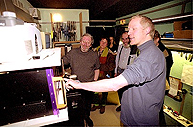Interview
with Jens Schneiderheinze
Cinema & Kurbelkiste – Münster
by Elisabetta Brunella

Jens Schneiderheinze showing the digital projector installed at Cinema & Kurbelkiste
How interested are arthouse
cinemas in digital projection in Germany?
About 50 cinemas, mainly members of AG Kino – Gilde deutscher
Filmkunsttheater – or Bundesverband Kommunale Filmarbeit, became
part of CinemaNet Europe, starting in autumn 2004 or spring 2005 with
digital cinema. Now approximately 100 screens are equipped with LCD
or DLP projectors supplied by ROWO which meet the CinemaNet Europe requirements.
Also compatible with these two systems there are around 40 servers from
Ropa, which has equipped the cinemas with 1.4K projectors.
And on the distribution side,
what sort of offer is there in digital format?
In 2005 Salzgeber distributed 26 films as part of the contract with
the members of CNE. There were also around ten films from other distributors.
In 2006 there was more interest by the art-house distributors. Kinowelt
began to distribute in digital format, like X-Filme.
Alpha Medien Kantor has supplied films for children, digitalising old
titles. The result was not excellent from a technical point of view but
the offer for that particular audience sector was broadened. The documentary
We feed the world, distributed by Delphi, had great success.
Again in the field of documentaries Ventura has been very active whilst
EYZ Media has given us a special programme based on a series of 8 titles
on the topic of mental disorders that we have screened with commentary
by experts. A further series has already been announced on working conditions
and the theme of globalisation.
We can safely say that about 12 distributors have launched films in digital
format, some exclusively in digital format, some additionally to the 35mm
prints. It can also be observed that an increasing number of small art-house
distributors are now launching their films in dvd only.
Are there any programming commitments
for members of CinemaNet Europe? Who provides the projector?
The members of CinemaNet Europe are obliged to screen 26 films per year
till 2007. Since the start of CNE most of the projectors have been owned
by the cinemas. Only a small number of projectors were financed with a
leasing contract. The costs of the projectors for the cinemas were different,
because some got funding, others didn't. The box-office of the CNE films
is not really high and didn’t increase in the first 18 months. Some exhibitors
are also using the projector for alternative content, by screening special
digital advertisements or using it for video games.
But the income from the advertising is not very high, while the costs
for the digital projector are higher than for a normal one. So for the
moment the investment doesn’t really cover the costs.
There is a lot of talk of electronic
advertising as an additional source of revenues for cinemas. Is this already
happening in Germany?
No, it isn’t. Only ROWO is distributing digital advertising on their own
systems. So there is not much income with advertisements in digital format.
On the other hand, to acquire your own local advertising for digital screenings
is a good way to improve the cinema’s income, but also gives you a lot
of work.
Would you like to comment on the interview
with Kees Ryninks (published in the “DGT online informer” no. 3), talking
about the technology chosen by CNE as an alternative to that recognized
by the DCI specs?
Kees Ryninks is right when he says that alternative content is a very
important possibility to get more and new audiences. The classic music
programme by Salzgeber is particularly successful in Germany. But for
all alternative content you need your own special and good-quality advertising.
It's the same for small digital films for a niche audience. Advertising
for these films is much more expensive.
Digital cinema gives us, as Kees said, more flexibility and more possibilities
for experiments. I agree, but we still can't use the servers as we want
to. We are still not able to put our own content on the server. For our
advertising or our own short film programme a second computer is still
necessary.
I agree with Kees about the technical standard and the DCI. 1.4K is good
enough for small screens. The problem nowadays is the bad quality of the
digital data, especially if the distributors give you a dvd. But unfortunately
we also have this problem with 35mm prints.
In my opinion digital cinema is still a pilot project. The equipment is
too expensive especially for small cinemas and there is no real economic
reason for the cinemas to go digital. Up to now we don't know how long
we can use our technology for and how high the total of the costs is.
Unless there is total interoperability and a positive return on the investments
made by the cinemas, it is of no commercial interest to them to invest
in digital technology.
The advantages are of a different sort: for example films can be obtained
more rapidly, particularly low-budget ones, and kept on the big screen
for a longer period. Special initiatives, including those of local interest,
can be organised. This makes it possible both to have advertising aimed
at a specific target and – something we often do in our cinema – to rent
the theatre for private screenings.
The Cinema & Kurbelkiste of Münster is
a small arthouse complex with three screens, with a total of 270 seats.
Two screens are equipped with a digital projector which can also be used
for projecting films on dvd. It is a member of AG Kino, the German association
of arthouse cinemas, and belongs to CinemaNet Europe.